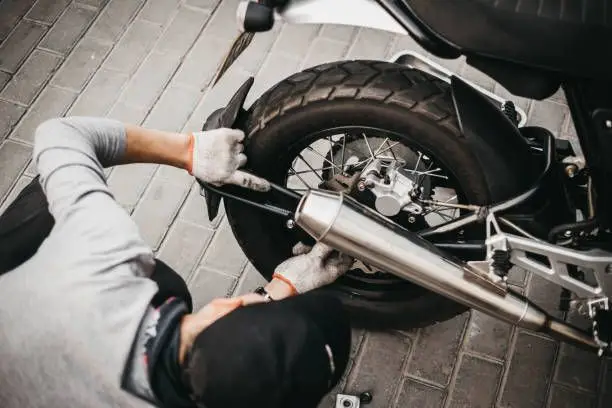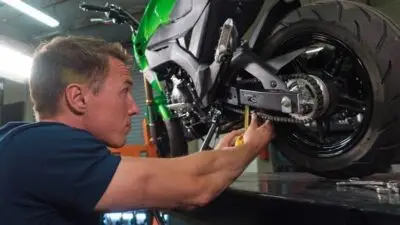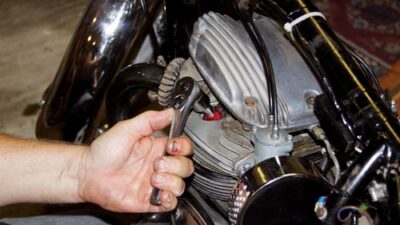Keeping your motorcycle in top condition requires regular maintenance, and one of the most basic yet crucial tasks is checking and tightening bolts and fasteners. Loose bolts can lead to dangerous situations on the road, from parts falling off to complete mechanical failures. Properly tightened fasteners ensure your motorcycle operates safely and efficiently, extending the life of your bike and preventing costly repairs.

When approaching motorcycle maintenance, understanding the correct tightening technique is just as important as knowing which bolts need attention. Different bolts require different torque specifications, and using the right tools makes all the difference. Some bolts may need special treatment, such as cleaning old thread locker before applying new material to ensure proper securing.
Regular bolt checks should be part of your maintenance routine, especially after the first few hundred miles on a new bike or after making repairs. Each type of fastener has recommended tightening torques that should be followed carefully to avoid stripping threads or damaging components while still ensuring everything stays securely in place.
Key Takeaways
- Regular inspection and proper tightening of motorcycle fasteners prevents mechanical failures and ensures rider safety.
- Using the correct torque specifications and appropriate tools is essential for properly securing different types of bolts.
- Applying thread locker and following manufacturer guidelines helps maintain fastener integrity over time and through vibrations.
Understanding Motorcycle Bolts and Fasteners
Motorcycle bolts and fasteners form the critical skeleton that holds your bike together. These components work under extreme stress and vibration, making proper identification and installation essential for safety and performance.
Types of Motorcycle Bolts
Motorcycles utilize several specialized bolt types, each designed for specific applications. Hex bolts are the most common, featuring a six-sided head that provides good grip for wrenches and sockets.
Socket head cap screws (Allen bolts) use an internal hexagonal drive and are common in engine cases and covers. These provide a clean appearance and resist stripping.
Flange bolts include a built-in washer surface that distributes pressure over a wider area, making them ideal for soft materials or locations with high vibration.
Pinch bolts secure components that clamp around cylindrical parts like fork tubes in the lower triple clamp. These act like springs when tightened, creating clamping force.
Shoulder bolts feature a non-threaded section that acts as a pivot point, common in foot pegs and levers.
Common Fastener Materials
Steel is the most common material for motorcycle fasteners, offering excellent strength at reasonable cost. Grade markings on bolt heads indicate strength – Grade 8 (US) or 10.9 (metric) bolts are high-strength and used in critical applications.
Stainless steel fasteners provide excellent corrosion resistance but are slightly weaker than comparable high-grade steel bolts. They’re ideal for external components exposed to weather.
Titanium bolts offer exceptional strength-to-weight ratio, reducing unsprung weight. However, they’re significantly more expensive and usually reserved for performance applications.
Aluminum fasteners are lightweight but suitable only for non-critical applications like bodywork attachment. They should never replace steel in load-bearing areas.
Remember that mixing materials can cause galvanic corrosion, particularly when aluminum meets steel in wet environments.
Identifying Critical Fastening Points
Some motorcycle fasteners require special attention due to their critical safety function. Engine mounting bolts secure the powerplant to the frame and must be properly torqued to prevent vibration damage.
Wheel axles and axle pinch bolts are perhaps the most safety-critical fasteners, as they hold your wheels securely to the motorcycle. Always torque these to exact specifications.
Brake caliper mounting bolts must be secure to ensure proper braking function. These typically use thread-locking compound to prevent loosening.
Steering stem and triple clamp bolts directly affect handling and control. Improper torque can cause dangerous steering issues or damage to fork tubes.
Swingarm pivot bolts support the entire rear suspension assembly. These fasteners experience extreme forces and need precise torque to allow proper movement while maintaining security.
Essential Tools and Supplies
Properly maintaining motorcycle fasteners requires specialized tools and products designed for precision and reliability. Having the right equipment ensures your bike stays safely assembled through vibration and regular use.
Selecting the Right Torque Wrench
A quality torque wrench is the most important tool for motorcycle maintenance. These precision instruments allow you to tighten bolts to exact specifications, preventing damage from over-tightening or safety issues from loose fasteners.
For most motorcycles, a 3/8-inch drive torque wrench with a range of 5-60 Nm covers common torque values. Many riders also keep a 1/4-inch drive for smaller fasteners and a 1/2-inch drive for larger applications like axle nuts.
Digital torque wrenches offer precise readings and easy adjustment, while beam-style wrenches are more affordable but require careful reading. Click-type wrenches are the most popular choice as they notify you with a click when reaching the set torque.
Always store torque wrenches at their lowest setting to maintain calibration, and have them recalibrated annually for accuracy.
Using Penetrating Oil and Impact Drivers
Penetrating oil is essential for loosening stuck or rusted fasteners without damaging threads. Apply it to stubborn bolts and let it sit for 10-15 minutes before attempting removal.
Quality brands like PB Blaster, Liquid Wrench, and WD-40 Specialist Penetrant work by seeping into microscopic spaces between threads to break down corrosion.
For extremely stubborn fasteners, an impact driver can be invaluable. These tools convert the force of a hammer blow into rotational force, helping break free seized bolts without stripping heads.
Manual impact drivers are affordable and work well for occasional use. For frequent maintenance, consider a pneumatic or electric impact driver with adjustable torque settings.
Always use impact-rated sockets with these tools to prevent cracking or shattering during use. After removing seized bolts, clean and inspect threads carefully before reinstallation.
Choosing Threadlockers: Loctite and Alternatives
Threadlockers prevent fasteners from vibrating loose, a critical safety feature on motorcycles. Loctite is the most recognized brand, offering various formulations for different applications.
Common threadlocker types:
- Blue Loctite (242): Medium-strength for regular maintenance; can be removed with hand tools
- Red Loctite (271): High-strength for critical fasteners; requires heat for removal
- Purple Loctite (222): Low-strength for small fasteners and adjustable parts
Apply threadlockers to clean, dry threads in small amounts. A single drop is usually sufficient for most motorcycle bolts. Too much can make future removal difficult.
Alternative brands like Permatex and Vibra-TITE offer similar products, often at lower prices. Some riders also use wicking grades that can be applied to already-assembled parts when disassembly isn’t practical.
Preparing to Tighten Motorcycle Bolts
Before you start tightening any motorcycle bolts, proper preparation ensures the job is done correctly and safely. Taking time to inspect, clean, and select the right components will prevent stripped threads, broken fasteners, and future mechanical issues.
Inspecting Bolt Threads and Fasteners
Begin by examining all bolt threads and fasteners for damage or wear. Look for signs of corrosion, stretching, or thread deformation that could compromise safety.
Damaged threads can cause improper torque readings and may fail under stress. If a bolt shows rounded edges or stretching, replace it immediately with the correct grade and size for your motorcycle model.
Check the bolt heads for any signs of rounding or stripping. Six-point sockets are better than 12-point sockets for preventing bolt head damage during tightening.
For critical fasteners like those on brake calipers, engine mounts, and suspension components, inspect them more carefully. These fasteners directly affect your safety while riding.
Cleaning and Lubricating Threads
Clean all bolt threads and holes thoroughly before reassembly. Use a wire brush to remove dirt, rust, and old thread-locking compound.
For stubborn or rusted bolts, apply a quality penetrating oil and allow it to soak for 15-30 minutes. This helps break down corrosion and prevents damage when removing tight fasteners.
Apply the appropriate lubricant to clean threads:
- Standard bolts: Light machine oil or anti-seize compound
- Exhaust fasteners: High-temperature anti-seize
- Critical fasteners: Thread-locking compound (blue for removable joints, red for permanent)
Proper lubrication ensures accurate torque readings. Dry or dirty threads can cause a bolt to feel tight before it’s properly secured.
Selecting Proper Washers and Nuts
Choose appropriate washers and nuts for each application. Washers distribute load and prevent damage to surfaces when tightening.
Types of washers to consider:
- Flat washers: Basic load distribution
- Lock washers: Prevent loosening from vibration
- Specialty washers: For specific applications (copper for exhaust)
Use self-locking nuts in areas with high vibration. Nylon-insert lock nuts are ideal for most applications, while all-metal lock nuts work better for high-temperature areas.
Match nut grade to bolt grade for consistent strength. Using a lower-grade nut with a high-grade bolt creates a weak point in the fastening system.
For critical fasteners, consider using Loctite and proper torque values based on bolt size. For example, apply approximately 25 Nm for M8 bolts and 35 Nm for M10 bolts, unless your service manual specifies otherwise.
Determining Correct Torque Specifications
Using the right amount of force when tightening motorcycle bolts is critical for safety and performance. Incorrect torque can lead to damaged parts or dangerous failures while riding.
Finding Manufacturer Torque Specs
The most reliable source for torque specifications is your motorcycle’s service manual. These manuals contain detailed tables listing the correct torque for each fastener on your specific bike. If you don’t have the original manual, digital versions are often available online from the manufacturer.
Aftermarket repair manuals like Haynes or Clymer also provide comprehensive torque values. These resources organize specs by system (engine, suspension, frame) for easy reference.
For those who prefer digital options, many manufacturers now offer mobile apps or online resources with complete torque specifications. Some specialty websites and forums dedicated to specific models (particularly for brands like Harley-Davidson and Buell) share detailed torque data.
Variations by Motorcycle Make and Model
Torque specifications vary significantly between different motorcycle makes and models. A bolt on a Harley-Davidson might require completely different torque than a similar-sized bolt on a metric motorcycle.
Torque values depend on several factors:
- Bolt size and grade: Larger and higher-grade bolts typically require more torque
- Material: Fasteners connecting aluminum parts need different torque than steel
- Location: Critical components like engine mounts and steering heads have precise specifications
Japanese and European motorcycles generally use metric fasteners with torque measured in Newton-meters (Nm). American bikes like Harley-Davidson often use foot-pounds (ft-lbs) or inch-pounds (in-lbs).
When working on motorcycles without factory specifications, mechanics can use standard torque charts based on bolt size and grade, though this should be a last resort.
Step-by-Step Guide to Tightening Motorcycle Bolts
Properly securing fasteners on your motorcycle is crucial for safety and performance. Using the right tools and techniques will ensure your bike stays together even during intense rides.
Applying Proper Torque with a Wrench
A torque wrench is essential for motorcycle maintenance. This specialized tool helps you apply the exact amount of force needed for each bolt.
Always refer to your motorcycle’s service manual for specific torque values. Different parts require different amounts of torque – an axle might need 65 ft-lbs while a pinch bolt might only need 15 ft-lbs.
When tightening multiple bolts in one area (like a lower triple clamp), use a crisscross pattern. This ensures even pressure distribution and prevents warping.
For critical components that affect steering or braking, proper torque is non-negotiable. Over-tightening can strip threads or break bolts, while under-tightening can lead to parts coming loose.
Set your torque wrench to the specified value, then turn slowly until you hear the click or feel the mechanism release.
Using Threadlocker for Enhanced Security
Threadlocker compounds help prevent fasteners from vibrating loose. Blue Loctite is the most common choice for motorcycle applications.
Apply a small drop to clean, dry threads before assembly. Too much can make future removal difficult, while too little won’t be effective.
Important applications include:
- Engine mounting bolts
- Handlebar clamps
- Footpeg brackets
- Brake caliper mounts
Don’t use threadlocker on parts that require frequent adjustment or removal. Also avoid using it on plastic components or with nylon-insert lock nuts.
Red Loctite should only be used for permanent installations, as it requires heat for removal. For most motorcycle applications, blue is the safer choice.
Re-Checking Critical Fastener Points
After initial tightening, check fasteners again after your first ride and regularly thereafter. Vibration can cause even properly torqued bolts to loosen.
Create a checklist of critical areas to inspect before each ride:
- Axle nuts and pinch bolts
- Handlebar mounts
- Brake caliper mounts
- Chain adjusters
- Engine mounting bolts
Look for signs of movement like dust rings around bolt heads or nuts. These indicate the fastener has rotated slightly.
Check chain tension as part of your regular maintenance. Proper tension is typically 15-20mm of vertical movement at the midpoint.
After any maintenance work, double-check your torque values, especially on steering components and wheel bearings where incorrect settings can affect handling.
Addressing Common Issues During Bolt Tightening
Even with the right tools, motorcycle bolt tightening can present challenges that require specific techniques and knowledge to overcome. Problems like corrosion and proper tension management are common but solvable with the right approach.
Dealing with Stubborn or Corroded Bolts
Corrosion is a primary enemy of motorcycle fasteners, creating stubborn bolts that resist normal removal efforts. When facing a corroded bolt, apply penetrating oil to the fastener and wait approximately 20 minutes for it to work into the threads.
For extremely stubborn bolts, try these methods:
- Heat application: Using a heat gun to expand the metal can break corrosion bonds
- Gentle tapping: Light hammer strikes to the bolt head can help break surface rust
- Impact driver: This tool delivers rotational force with downward pressure, ideal for stuck fasteners
Never force a severely corroded bolt as this risks breakage. If a bolt seems too damaged, consider replacement rather than continued attempts at loosening.
Preventing Over-Tightening and Stripped Threads
Over-tightening is as problematic as under-tightening. Using a torque wrench is crucial – stop turning once you hear a click or feel resistance. This prevents damaging both the fasteners and the components they secure.
For proper tension management:
- Clean bolt threads before installation
- Apply appropriate lubricant when specified
- Use the manufacturer’s recommended torque values (typically 25 Nm for M8 bolts, 35 Nm for M10)
- Tighten in sequences for multi-bolt assemblies
Thread-locking compounds like Loctite can prevent loosening while maintaining proper tension. Select the appropriate strength – blue for removable applications and red for more permanent fastening needs.
Maintaining Fastener Integrity Over Time
Keeping motorcycle fasteners secure requires both proper initial installation and ongoing maintenance. The vibrations and stresses of regular riding can gradually loosen even properly torqued bolts.
Managing Vibration and Its Effects
Motorcycle engines and road conditions create constant vibration that works against your fasteners. To combat this, consider using thread-locking compounds like Loctite on critical bolts. These come in different strengths:
- Blue Loctite: Medium strength, removable with hand tools
- Red Loctite: High strength, requires heat for removal
- Green Loctite: For sealing threaded connections
Lock washers and nylon-insert lock nuts also help prevent loosening from vibration. Safety wire provides excellent protection for critical fasteners on race bikes or high-performance motorcycles.
Proper torque specifications are essential. Under-torqued bolts can work loose, while over-torqued bolts may stretch or break. Using a torque wrench allows precise tightening to manufacturer specifications.
Regular Inspection and Retightening Intervals
Most maintenance manuals recommend checking fasteners every 3,000-5,000 miles. Critical components deserve more frequent attention. Create a systematic inspection plan for different parts of the motorcycle:
Weekly Checks:
- Engine mounting bolts
- Handlebar and control fasteners
- Wheel axles and pinch bolts
Monthly Checks:
- Frame fasteners
- Suspension mounting points
- Exhaust system bolts
A general spanner check should include all accessible fasteners. Pay special attention after riding in harsh conditions or performing repairs.
When retightening, clean threads of dirt and old compounds. Apply fresh thread locker where needed and tighten to the correct bolt torque using a calibrated torque wrench.
Special Considerations for Harley and Buell Motorcycles
Harley-Davidson and Buell motorcycles require specific attention to fastener maintenance due to their vibration characteristics. Using the correct torque values and thread-locking compounds is essential for keeping these American motorcycles safely on the road.
Typical Fastener Locations on Harley Models
Harley-Davidson motorcycles have several critical fastener locations that need regular inspection. Five key areas require tightening on Harley motorcycles, with Sportsters being particularly prone to loose bolts. Common problem areas include:
- Primary cover bolts: These frequently vibrate loose and should be checked monthly
- Exhaust mounting hardware: Heat cycles cause expansion and contraction
- Handlebar controls: These affect steering safety
- Footpeg mounts: Critical for rider stability
- Chin fairing fasteners: Known to rattle loose over time
Applying blue Loctite to these fasteners helps prevent loosening from vibration. For Harley engines, always use a calibrated torque wrench rather than feel alone.
Many owners find that checking every nut and bolt regularly is necessary for Harleys due to their vibration characteristics.
Bolt Tightening Differences for Buell
Buell motorcycles, while related to Harley-Davidson, have unique fastener considerations. Many Buell models use Torx-head fasteners instead of standard hex bolts, requiring specific tools for maintenance.
Critical areas on Buell motorcycles include:
- Frame-to-engine mounting points: These affect handling characteristics
- Chin fairing hardware: Prone to vibrating loose as reported by owners
- Suspension components: Require precise torque for proper function
For Buell fasteners, follow these guidelines:
- Use medium-strength (blue) thread locker on most fasteners
- Apply proper torque values (typically 25 Nm for M8 bolts, 35 Nm for M10)
- Re-check after the first ride and then at regular service intervals
Buell motorcycles benefit from two important reasons for correct torquing: safety (preventing loose fasteners) and damage prevention.
Conclusion
Proper bolt tightening is essential for motorcycle safety and performance. Following the correct procedures prevents mechanical failures and ensures your bike stays in top condition.
Always use a quality torque wrench when working on your motorcycle. This tool helps achieve the precise tension needed for each fastener type and location. Remember that bolt torque is simply force multiplied by distance, making it measurable and repeatable.
When tightening critical components, follow a crisscross pattern and work in stages. This distributes pressure evenly and prevents warping.
Take time to learn the specific torque values for your motorcycle model. These specifications exist for good reason – when a bolt tightens, it stretches slightly to create tension. Too loose or too tight can be equally problematic.
Regular maintenance should include checking fastener tightness. Vibration can gradually loosen bolts during normal riding conditions.
Invest in quality tools and fasteners for best results. Using the proper torque wrench technique means turning clockwise to tighten and utilizing the automatic return function correctly.
With practice and attention to detail, proper fastener tightening becomes second nature. This simple skill significantly improves motorcycle reliability and rider safety.
Frequently Asked Questions
Proper maintenance of motorcycle fasteners requires specific knowledge about torque specifications, tools, and techniques. Understanding these key elements helps prevent mechanical failures and ensures your motorcycle operates safely.
What is the proper technique for tightening bolts on a motorcycle?
The proper technique for tightening motorcycle bolts involves using the correct torque value for each specific fastener. Correct torque keeps items fastened together without compromising either the parts or the fastener itself.
When tightening, mechanics should clean the threads thoroughly and apply the appropriate thread compound if needed. For bolts requiring Loctite, it’s important to clean old Loctite with a wire brush and use brake cleaner before applying fresh compound.
Tighten bolts in a cross pattern or sequence when working with components like engine covers or cylinder heads. This ensures even pressure distribution and prevents warping.
Where can I find a motorcycle bolt torque specification chart?
Motorcycle bolt torque specifications can be found in the vehicle’s service manual, which is the most reliable source for model-specific information. Many manufacturers provide digital versions of these manuals online.
Generic torque charts are widely available online, organized by bolt diameter and grade. These charts can serve as guidelines when specific values aren’t available.
Forums dedicated to specific motorcycle brands often have torque specification threads where riders share official documentation. Websites like Revzilla also provide technical articles with torque information.
Can you provide the torque specifications for Honda motorcycle fasteners?
Honda motorcycle fastener specifications vary significantly by model, year, and specific application on the bike. General fastener guidelines for common Honda motorcycles include 8-10 ft-lbs for M6 bolts and 16-18 ft-lbs for M8 bolts.
Critical components like engine mounting bolts, suspension pivot points, and brake caliper bolts have unique specifications. These should always be referenced from the official Honda service manual for the specific motorcycle model.
For fairings and non-critical components, Honda typically recommends lower torque values. Fairing bolts should be tightened carefully to avoid cracking plastic components.
Which tools are recommended for securing motorcycle bolts and fasteners?
A quality torque wrench is essential for properly securing motorcycle fasteners. For small fasteners, an inch/pound torque wrench provides the precision needed, while foot/pound wrenches work better for larger bolts.
Socket sets with various sizes and extensions help reach difficult spots. Both metric and standard sets may be necessary depending on the motorcycle’s origin.
Allen wrenches (hex keys) are crucial for many motorcycle fasteners. Using the long end of the allen wrench in the bolt head and the short end for leverage helps prevent overtightening.
What methods should be used to ensure bolts on a motorcycle are tightened correctly?
Using a calibrated torque wrench is the most reliable method to ensure proper tightening. This tool measures the exact amount of force applied, preventing both under and overtightening issues.
Some mechanics prefer to use grease or oil on bolts instead of installing them dry, which creates a more consistent torque-tension relationship. However, this practice should be avoided where thread-locking compounds are specified.
For bolts without specific torque values, experienced mechanics often use the “feel method,” tightening until snug and then adding a specific amount of turn. This requires experience and should be approached cautiously.
How often should I check and retighten the fasteners on my motorcycle?
Motorcycle fasteners should be checked before every riding season and after any major service work. Critical fasteners that affect safety should be inspected more frequently.
After the first 500 miles on a new motorcycle or following major repairs, it’s advisable to check all accessible fasteners as they may settle with initial use. All bolts have a torque spec that should be maintained.
Riders who frequently travel on rough roads or participate in off-road riding should establish a more frequent checking schedule. Vibration from these conditions can loosen fasteners more quickly than normal street riding.













